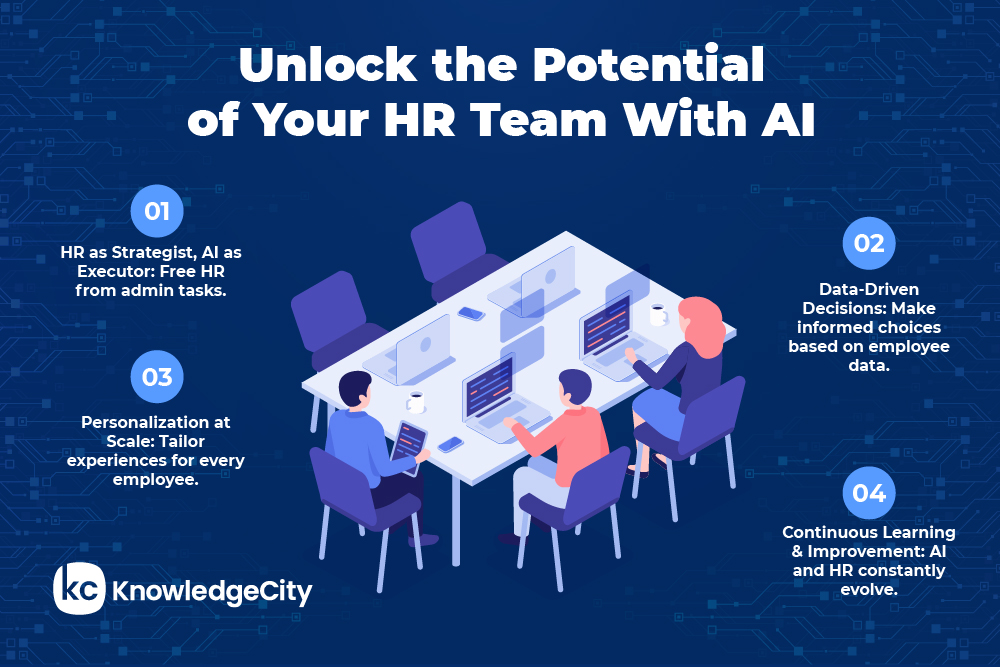With the rise of artificial intelligence (AI), Human Resources departments must learn to change with the times. According to Gartner, 38% of HR leaders have explored or implemented AI solutions to improve process efficiency within their organizations.

One of the most exciting developments in HR is the integration of generative AI. In this article, we will explore what generative AI is, how it can benefit HR practices, and how HR professionals can embrace this technology to drive innovation and automation in their organizations.
What is Generative AI?
Generative AI is a powerful technology that goes beyond simply analyzing data, as it can create entirely new content, ideas, and even products. Imagine having a creative partner that can churn out marketing copy, design variations, and more.
Also known as generative adversarial networks (GANs), generative AI uses two neural networks to generate new data. One network, known as the generator, creates new data based on patterns it has learned from existing data.
The other network, known as the discriminator, evaluates the generated data and provides feedback to the generator. This process continues until the generator is able to create data that’s indistinguishable from the original data.
Businesses are leveraging this tool in several ways to help overcome creative roadblocks and suggest new possibilities that humans might miss. As this technology continues to evolve, we can expect more groundbreaking applications that will reshape the future of business.
The Benefits of Generative AI
Generative AI has the potential to revolutionize HR practices in several ways. Here are some of the key benefits of integrating generative AI into HR:
- Improved Recruitment and Selection
Generative AI can analyze large amounts of data to identify the patterns and characteristics of successful employees. According to a survey from Workable, Some 90% of HR professionals say AI has sped up their hiring, while 77.9% say it’s saved them money.This helps HR professionals make informed decisions when it comes to recruitment and selection, leading to better hires and reduced turnover.
- Efficient Onboarding
With generative AI, HR professionals can create personalized onboarding experiences for new employees based on their individual strengths and weaknesses. This makes new employees feel more engaged and motivated, leading to higher retention rates.
- Enhanced Employee Development
Generative AI can analyze employee data to identify areas for improvement and create personalized development plans for each employee. This can lead to more effective training and development programs, resulting in a skilled and committed workforce.
- Streamlined Performance Management
By analyzing employee data, generative AI can provide real-time feedback and recommendations for improving performance. This can aid HR professionals in identifying and addressing performance issues before they become major problems.
- Efficient Workforce Planning
Generative AI can analyze data on employee skills, experience, and performance to help HR professionals make more accurate predictions about future workforce needs. This can help organizations plan for growth and identify any potential skills gaps.
Although generative AI appears to have plenty of potential, that potential goes hand-in-hand with ethical considerations and privacy concerns that require careful and thoughtful navigation.
One major challenge of generative AI is bias. Generative AI models, trained on existing data, can amplify any biases present in that data. For example, an AI tasked with recruiting may unintentionally favor certain demographics based on past hiring patterns. To mitigate this, companies need diverse training data and fairness checks to ensure AI output is unbiased.
The ability to create realistic content raises another big concern: misinformation. Generative AI can be used to create deepfakes that can compromise communication and trust within the workplace. Imagine a deepfake video of a CEO making false announcements, creating confusion and spreading misinformation. To combat this, companies must promote employee education and set clear policies when it comes to AI-generated content.
Data privacy and security are also key considerations to keep in mind. Since generative AI often relies on access to personal data, this can make employees hesitant to work with these tools for fear of misuse. Companies must be transparent about data collection practices and implement robust security measures to protect sensitive information.
Another challenge is the lack of transparency in generative AI. The complexities of these models make it difficult to understand how they really work. For example, if an AI recommends firing an employee, it’s necessary for HR to understand the reasoning behind that decision. Companies must strive for explainable AI models that can justify their outputs.
There’s also the concern of job displacement as generative AI automates additional tasks. This can make employees feel as if they’re going extinct. But, new roles will emerge. During this transition period, companies should invest in reskilling and upskilling programs to help employees adapt to the evolving workplace.
Embracing AI as a Strategic HR Partner
The future of HR is collaborative, and AI is poised to become HR’s most valuable partner. This partnership goes beyond simply delegating tasks; it’s about leveraging AI’s strengths to empower HR professionals and elevate their strategic impact. Here’s how this dynamic can revolutionize the workplace:
- HR as the Strategist, AI as the Executor: Imagine HR professionals freed from the burden of administrative tasks like scheduling interviews or sorting through resumes. AI can handle these efficiently, allowing HR to focus on higher-level work. This could involve crafting talent acquisition strategies or designing leadership development programs.HR becomes takes on the role of a strategist, planning the overall employee experience, while AI acts as the builder, executing tasks with precision and speed.
- Data-Driven Decisions, Human-Centered Approach: HR decisions are often based on intuition and experience. AI can introduce a powerful new element: data. By analyzing vast troves of employee data, AI can uncover hidden patterns and trends.For example, AI might identify potential for burnout among certain teams or pinpoint skills gaps across departments. Equipped with these insights, HR can make data-driven decisions about workload distribution, training programs, and employee wellness initiatives.
However, the human aspect remains irreplaceable. HR professionals must interpret this data through a human lens and consider employees’ emotions and motivations, as well as the unique dynamics of a given workplace. This ensures that AI-driven insights are translated into actionable strategies that prioritize employee well-being.
- Personalization at Scale: Picture a world where each employee receives a tailored onboarding experience, a personalized career development path, and a compensation package that reflects their unique value. AI can make this a reality.By analyzing employee data and preferences, AI can recommend relevant training programs, suggest career development opportunities, and even personalize onboarding experiences based on an employee’s background and role. HR professionals can then leverage this information to curate a truly personalized employee journey, fostering a sense of belonging and engagement.
- Continuous Learning and Improvement: The HR-AI partnership works like a feedback loop: As AI interacts with employees and analyzes data, it continuously learns and refines its processes. HR professionals can monitor this process and adapt their strategies accordingly.For example, if AI identifies a bias in the performance evaluation process, HR can work to address it and ensure fair and objective assessments. This continuous feedback loop ensures that both HR and AI are constantly evolving to better serve the needs of the company.
The key to unlocking the full potential of this partnership lies in clear communication and collaboration. HR professionals need to understand AI capabilities and limitations, while AI systems must be designed with human oversight and ethical considerations in mind.
When these elements come together, the HR-AI partnership can transform the workplace into a more efficient, data-driven, and ultimately, more human-centric environment.
Integrating AI into HR Strategy
Here are some steps you can take to embrace generative AI in your organization:
- Educate Yourself and Your Team: The first step to embracing generative AI is educating yourself and your team. Attend conferences, workshops, and webinars to learn more about generative AI and how it can benefit HR practices. Share your knowledge with your team and encourage them to do the same.
- Identify Areas for Improvement: Take a close look at your current HR practices and identify areas where generative AI could make a difference. This could be in recruitment and selection, onboarding, performance management, or any other area where data analysis could lead to better outcomes.
- Choose the Right Tools: There are many generative AI tools available on the market, so it’s important to choose the right one for your organization. When making your decision, consider factors such as cost, ease of use, and compatibility with your existing systems.
- Start Small and Scale Up0: It can be overwhelming to implement a new technology across your entire organization all at once. Instead, start small and focus the AI in one area of HR. Once you’ve seen the benefits, you can scale up and integrate it into other areas.
Integrate Generative AI with KnowledgeCity
Generative AI has the potential to revolutionize HR practices by improving recruitment and selection, onboarding, employee development, performance management, and workforce planning. By educating yourself and your teams, identifying areas for improvement, choosing the right tools, and starting small, HR can embrace this technology and drive innovation and automation in their organizations. The future of HR is here, and it is time to embrace it.
Subscribe to Our Newsletter
Join 80,000+ Fellow HR Professionals. Get expert recruiting and training tips straight
to your inbox, and become a better HR manager.

 KnowledgeCity
KnowledgeCity 










